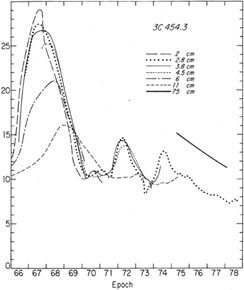Copyright © 1981 by Annual Reviews. All rights reserved
| Annu. Rev. Astron. Astrophys. 1981. 19:
373-410 Copyright © 1981 by Annual Reviews. All rights reserved |
The early observations of radio flux density variations and their interpretation in terms of expanding synchrotron sources was reviewed by us previously (Kellermann & Pauliny-Toth 1968). Since that time a wealth of data has been accumulated, which we summarize here. Figure 2 illustrates the manner in which the flux density varies with time and wavelength in the quasar 3C 454.3. There is no clear distinction between quasars and radio galaxies in the nature of the flux density variations, although the most rapid variations appear to occur in the BL Lac objects.

|
Figure 2. Flux density variations observed in the quasar 3C 454.3 over a range of wavelengths. Data are from Andrew et al. (1978), Altschuler & Wardle (1976), Kellermann & Pauliny-Toth (1968 and unpublished), Dent et al. (1974), Dent & Kaptisky (1976), Dent & Kojoian (1972). |
Most compact radio sources show flux density variations. Often there are multiple outbursts on a time scale of a year or so, but in some sources there is only a slow increase or decrease which may last ten or more years. Detailed analysis and quantitative comparison with theoretical models is difficult since different outbursts blend together in both frequency and time or are superimposed on a slowly varying event. On the basis of data spanning nearly 15 years, however, some general remarks can be made about the nature of flux variations (Altschuler & Wardle 1977, Kesteven et al. 1977, Andrew et al. 1978, Fanti et al. 1979, Fanti & Salvati 1980, and Webber et al. 1980).
(a) Variations are observed over a wide range of wavelengths extending from ~ 3 mm to ~ 1 meter. A specific event may be recognized over a range of about 100 to 1 in frequency.
(b) Often the amplitude of the outburst is nearly independent of wavelength, and the bursts occur simultaneously over a wide range of observed wavelengths. This is characteristic of an optically thin synchrotron source where the flux increase is due to the prolonged injection or acceleration of relativistic particles, and the decrease is due to adiabatic expansion or radiation losses. This type of behavior is seen particularly in BL Lac type objects, and at relatively long decimeter wavelengths (Fisher & Erickson 1980).
(c) The outbursts may also appear first at the shorter wavelengths, and then propagate with reduced amplitude towards longer wavelengths in the manner qualitatively expected from an adiabatically expanding synchrotron source that is initially opaque, but that becomes transparent at successively longer wavelengths as the source expands (Shklovsky Pauliny-Toth & Kellerman 1966, van der Laan 1966, Kellermann & Pauliny-Toth 1968). In general, however, the amplitude at the longer wavelengths is greater than expected from the simplest form of this model. Below some critical wavelength, where the source is initially transparent, the outburst appears simultaneously and with nearly equal amplitude at all wavelengths.
(d) In a few sources, which show prominent variations at relatively long wavelengths, the short wavelength variations are much weaker than would be expected, unless the variable component of the source is transparent at the shorter wavelengths and has a relatively steep spectral index.
It is not surprising that the observed dependence of flux density on wavelength and time does not follow the ideal model in which relativistic particles are instantly accelerated in an infinitesimal region that is initially opaque at all wavelengths, and that expands adiabatically with constant velocity and negligible radiation or inverse Compton losses. However, if account is taken of the initial size, spatial inhomogeneities, the effects of prolonged particle acceleration and energy losses, possible non-power-law electron energy distributions, and possible accelerations or decelerations, reasonably good fits to the data can be obtained (e.g. Peterson & Dent 1973, Aller & Ledden 1979, Preuss et al. 1979, and Fanti & Salvati 1980). In this way the observed flux density variations, which are directly related to the manner in which the central engine produces relativistic particles, give some insight into the early evolution of compact radio sources.